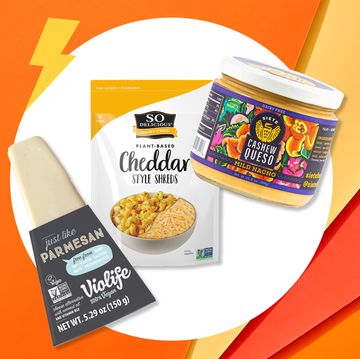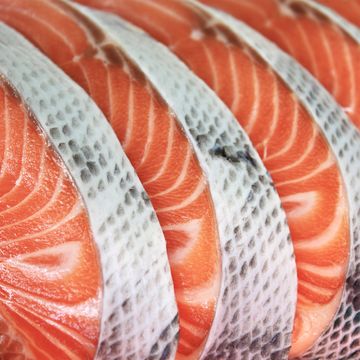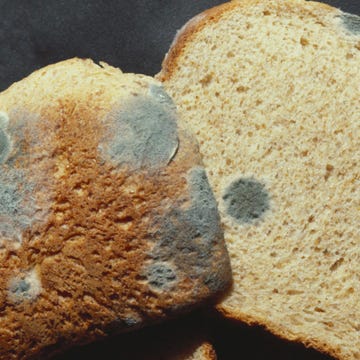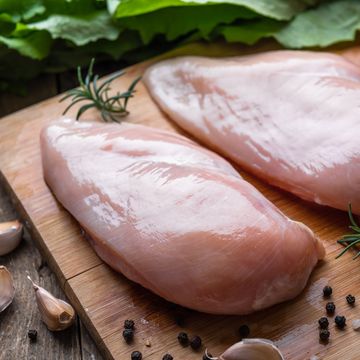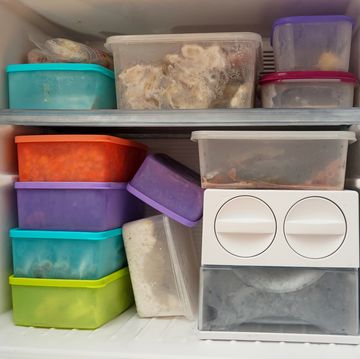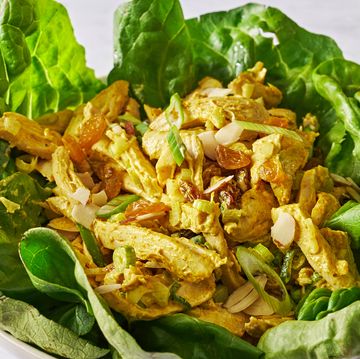There’s nothing more disappointing than sinking your teeth into a slice of bread and get a mouthful of green, fuzzy mold. The thought of that experience alone probably turns your stomach. It may also leave you wondering what happens if you eat mold accidentally and the potential harm you're doing to your body. Is this a see-your-doctor-immediately kind of situation?
First, relax. If you took a bite of some moldy food, don't worry. It’s extremely common, explains Keri Gans, RD, a New York-based nutritionist and author. And it’s super easy for mold to grow on food that’s soft and porous like bread, fruit, vegetables, and more, she adds.
This may surprise you—mold spores are all around us. They can enter a building through the air and attach to food and surfaces, and they are naturally present in soil and natural habitats where crops are grown, says Georgia Jones, PhD, an associate professor of food science at the University of Nebraska-Lincoln. It’s part of nature, so you can expect mold to pop up over time. That said, you can delay that by washing and storing your food properly.
More From Women's Health

Meet the experts: Keri Gans, RD, is a New York-based nutritionist and author. Georgia Jones, PhD, is an associate professor of food science at the University of Nebraska-Lincoln. Rudolph Bedford, MD, is a gastroenterologist at Providence Saint John’s Health Center in Santa Monica.
Basically, eating moldy food probably won't hurt you too much, let alone kill you, says Rudolph Bedford, MD, a gastroenterologist at Providence Saint John’s Health Center in Santa Monica.
But there are definitely a few things you should keep in mind. On rare occasions, mold *can* make you sick if you’re not careful. Here’s everything you need to know if you accidentally eat mold, according to experts.
Give it to me straight. What happens if I eat mold?
Don't run to the bathroom to scrub your tongue with a bar of soap just yet. “You’re not going to die from eating mold,” says Dr. Bedford. In fact, as long as your immune system is in good shape, you can digest it like any other food.
Though molds (a.k.a. microscopic fungi)—which creep up on plant and animal products after being transported there by air, water, or insects—can be dangerous, they usually aren’t, according to the USDA.
After all, molds are meant to be on certain foods—including dry-cured country hams and cheeses such as Brie and Camembert. In many of these cases, mold is totally safe to eat, the USDA says.
But what about the fuzzy green or white stuff that pops up unannounced on fruits, vegetables, bread, and dairy products?
You might feel sick after accidentally eating these molds, but that's most likely because the mold tastes bad, not because of any particular toxin in it, says Dr. Bedford.
The exception is if the mold you ate produces a particular type called mycotoxins. It is typically found in grain and nut crops, but also in celery, grape juice, apples, and other produce. It’s estimated by the Food and Agriculture Organization of the United Nations that around 25 percent of the world’s food crops contain mycotoxins, says the USDA. Even so, "minute amounts are unlikely to make someone sick, but these can accumulate in the liver and kidneys and cause health problems in the long term,” says Jones.
Dr. Bedford recommends waiting to see if your symptoms escalate beyond nausea before rushing to call the doctor. “The stomach is a harsh environment, so, for the most part, most bacteria and fungus won't survive,” he explains.
But what if I do get super sick from eating moldy food?
“It’s very uncommon that you’re going to get [really] sick from mold,” says Dr. Bedford. And in the rare instance that you do, you'll likely have had to consume large amounts of the stuff. (And, c'mon, are you really going to keep licking the fuzz off your food? I didn't think so.)
If the unlikely occurs, though, and your symptoms include persistent nausea and vomiting, you should definitely call the doctor, Dr. Bedford says. Typically, he'd just prescribe anti-nausea medication—but if you're really feeling miserable, he might prescribe something to induce vomiting or diarrhea to try to flush out your system.
In some cases, people have allergic reactions to certain molds, which can contribute to respiratory issues, says Dr. Bedford. But don't worry, they're usually temporary and easily treated by your doctor.
Ultimately, though, don't get too freaked out: In his 30 years of practice, Dr. Bedford says he has never seen anyone die or require more intense treatment due to mold (though that doesn't mean it's impossible).
And the good news is mold cannot grow in the stomach because it is too acidic. “Many human diseases are caused by fungal infections—on the skin and respiratory system. However, these are not truly associated with the consumption of moldy foods, whether the mold was used intentionally to ferment a food product or not,” says Jones.
Wait, can't I just cut the mold off of my food?
If you're not too skeeved out by that patch of mold on your eats, you might be tempted to just cut it off and continue eating, but whether or not this is actually a good idea depends on the food.
Though you only see their fuzzy discolored tops, all molds have “roots” that invade foods, according to the USDA. Since these roots allow toxins (if there are any) to spread throughout the inside of your food, your best move is to throw out the moldy food in its entirety, regardless of where you see the moldy patch, Dr. Bedford says.
Still, mold can't penetrate certain hard cheeses, hard salami, firm fruits, and vegetables as easily as softer foods, the USDA says. That makes these foods easier to save from a fuzzy patch. Just make sure to cut off at least an inch around and below the moldy spot, keep your knife out of the mold, and wrap the “good” part of the food in a new covering.
For quick reference, these food are generally okay to eat once you cut off any mold:
- Hard cheeses
- Hard salami
- Firm fruits
- Vegetables
These foods, meanwhile, should be thrown away if at all moldy:
- Soft cheeses (that are not meant to be moldy)
- Soft fruits, such as strawberries, grapes, blueberries, and peaches
- Baked goods
- Legumes
- Nuts
- Yogurt
- Jams
- Meat
- Bread
Also, FYI, toasting your bread will not kill the mold on it, so don't even go there. Since bread is super porous, it's definitely one to chuck at the first sign of fuzz, says the USDA.
But wait, isn't mold used to make certain foods?
In short, yes, mold is used to make some of your favorite foods like cheese, soy sauce, vinegar, yogurt, and more—which means that some mold is obviously not dangerous to eat, Gans explains.
For example, cheese is made with common molds like Penicillium strains. (Think of the stinky, rotted look of blue cheese and gorgonzola.) And yup, traditional soy sauces and vinegars use Koji, a fungus, to ferment and create that classic acidic, tart, and sometimes sweet taste.
But all of these molds are generally considered safe to eat, since they’re consumed as part of the food they’re used to make, Gans explains.
That said, when you see an unnatural growth occur on these foods, don’t disregard it, notes the USDA. If you find something funky popping up on these foods (picture anything uncharacteristically green, blue, and fuzzy), your best bet is still to cut off the area or discard the item entirely.
How can I prevent mold from forming in the first place?
Since warm, humid conditions encourage mold growth—and dry mold spores float through the air in search of new places in which to grow some more moldy friends—the USDA recommends a few best practices for keeping mold from messing with your food:
- Examine foods for mold before buying them
- Purchase food in small amounts so mold doesn't have time to grow
- Cover food with plastic wrap
- Stash food in the refrigerator quickly
- Eat leftovers within three or four days
- Clean your refrigerator regularly
- Keep your home's humidity level below 40 percent
Of course, molds can still grow in the refrigerator (albeit much more slowly), but following these guidelines can help keep your eats fresh and fuzz-free for as long as possible.
The bottom line: Eating moldy food probably won't make you sick, but most foods should be thrown away at the first sign of fuzz. To prevent mold growth, properly wrap all food and store it in a clean, dry refrigerator.
Lauryn Higgins is a freelance journalist whose work focuses primarily on public health. Her work tracking the coronavirus for The New York Times was part of a team that won the 2021 Pulitzer Prize for Public Service. When she's not working she loves spending time in her kitchen and garden, taking barre classes and cuddling with the love of her life, her 90-pound bernedoodle, Gus. Her work has also appeared in NPR, Salon, Teen Vogue and Well + Good.


